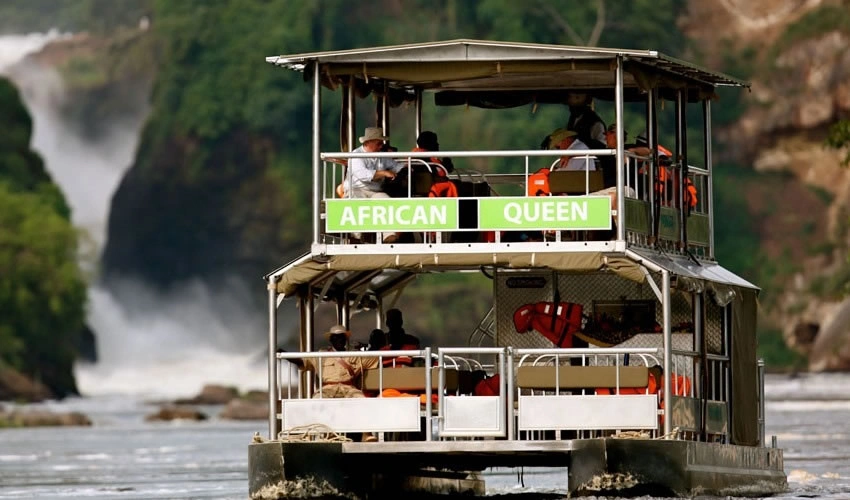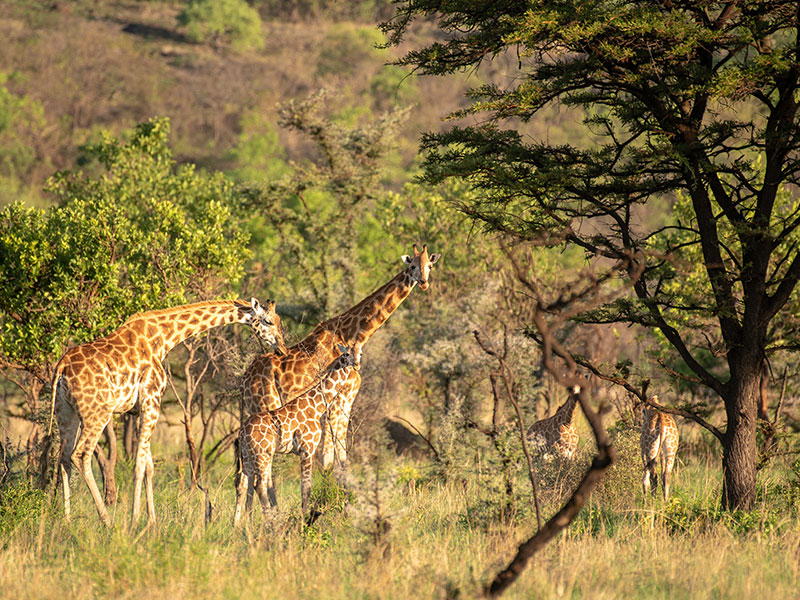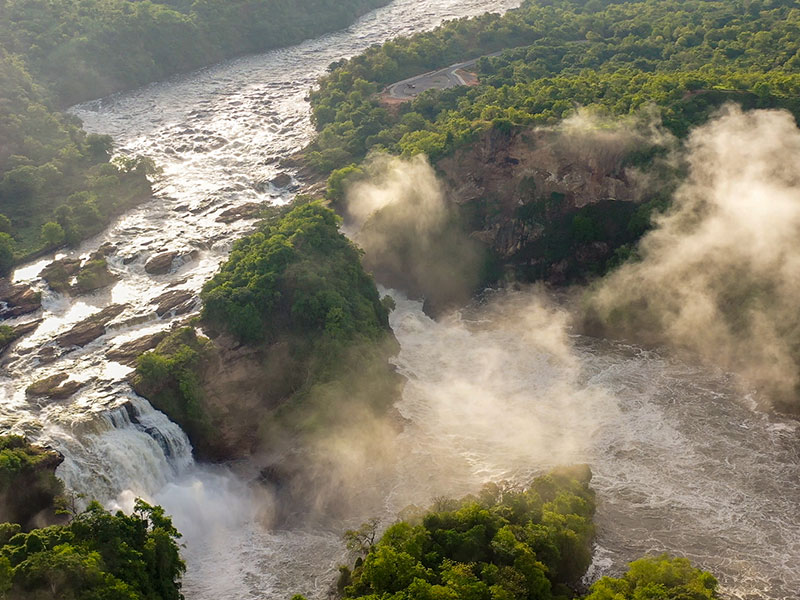
Murchison Falls National Park, located in northwestern Uganda, is one of the most renowned wildlife conservation areas in Africa. Spanning over 3,840 square kilometers, it is the largest national park in Uganda and one of the oldest in East Africa. Murchison Falls National Park is famous for its stunning landscapes, diverse ecosystems, and the iconic Murchison Falls, which is the park’s namesake and one of the most powerful waterfalls in the world.
The park is home to a rich array of flora and fauna, from savannah grasslands to dense tropical forests and riverine ecosystems, making it one of the most biologically diverse conservation areas in Uganda. Visitors can engage in various activities such as game drives, boat safaris, bird watching, and hiking, all while encountering unique species of animals and plants in their natural habitats. This comprehensive historical background and overview will delve into the park’s origins, key features, the unique species found in its boundaries, and practical information for those seeking to explore this iconic wilderness.
Historical Background of Murchison Falls National Park
Murchison Falls National Park was first gazetted as a wildlife reserve in 1926, making it one of the earliest protected areas in Uganda. However, the area’s natural beauty and importance were recognized long before that by local communities, explorers, and colonial authorities.
The park is named after Murchison Falls, which was christened by the famous British Explorer Sir Samuel Baker in 1864 after Sir Roderick Murchison, the then-President of the Royal Geographical Society. Baker was one of the first Europeans to explore the Nile River’s source and discover the falls. His journeys, documented in his writings, helped bring global attention to the region’s geographic and biological significance.
During Uganda’s colonial period, the British authorities established the park as a means of conserving the wildlife that was abundant in the area, particularly elephants, lions, giraffes, and other large mammals. After Uganda gained independence in 1962, the park was further protected, and conservation efforts were ramped up Unfortunately,
During the political instability of the 1970s and 1980s under Idi Amin and Milton Obote, poaching and neglect devastated the park’s wildlife populations. However, with the establishment of the Uganda Wildlife Authority (UWA) in the 1990s, the park has seen a dramatic recovery, with conservation efforts resulting in the resurgence of many animal species.
Location and Landscape of Murchison Falls National Park
Murchison Falls National Park is located in northwestern Uganda, straddling the districts of Buliisa, Nwoya, Kiryandongo, and Masindi. The park is approximately 300 kilometers (about 186 miles) from Kampala, Uganda’s capital, and it is well-connected by road, making it accessible to both local and international visitors.
The park lies at the northern end of the Albertine Rift Valley, where the massive Bunyoro escarpment merges into vast savannah plains. The most striking feature of the park’s landscape is the Nile River, which bisects the park from east to west. The river creates a wide range of ecosystems, from dense tropical rainforests in the west to expansive savannahs in the north.
Murchison Falls itself is the most famous geographical feature in the park. It is formed where the Nile River narrows from a width of over 50 meters to a mere 7 meters, plunging 43 meters into a gorge with tremendous force, creating a thunderous roar and a cloud of mist. This natural wonder is often regarded as the most powerful waterfall in the world.
The park’s landscape is incredibly diverse, with different sections offering varying scenery:
Savannah Grasslands: The northern part of the park is dominated by savannah grasslands, which provide excellent habitat for grazing animals like elephants, buffaloes, giraffes, and Uganda kob. This area is characterized by rolling plains dotted with acacia trees.
Woodlands: Surrounding the savannahs are areas of mixed woodlands and thickets, providing shelter for a variety of bird species and smaller mammals like warthogs and bushbucks.
Riverine Habitats: Along the Nile River, lush riverine forests thrive, providing habitat for hippos, crocodiles, and a wide variety of birds. The riverbanks are also an excellent place to spot elephants and other animals coming to drink.
Tropical Forests: To the west of the park, Budongo Forest is the largest tropical rainforest in the park. This section is home to chimpanzees and other primates, as well as a rich array of plant and bird species.
Delta Region: Where the Victoria Nile empties into Lake Albert, a delta forms, creating wetlands and marshes that are home to unique bird species like the elusive shoebill stork.
Flora and Fauna of Murchison Falls National Park
The flora and fauna of Murchison Falls National Park are incredibly diverse due to the wide range of ecosystems within the park. The park is home to over 76 mammal species, more than 450 bird species, reptiles, amphibians, and countless insects.
Mammals
Elephants: Murchison Falls National Park is home to a healthy population of African elephants. These magnificent creatures are often seen along the Nile River, bathing or feeding on the park’s lush vegetation.
Lions: The park is one of the best places in Uganda to spot lions. The lions here are often seen stalking their prey in the savannah grasslands, particularly in the northern section of the park.
Giraffes: The Rothschild giraffe, an endangered subspecies, is commonly found in Murchison Falls National Park. These tall animals are often seen grazing on acacia trees in the northern savannahs.
Buffaloes: African buffaloes are widespread throughout the park, often found in large herds in both the northern and southern sectors.
Leopards: Although more elusive, leopards are also present in the park, particularly in the woodlands and around the Nile River.
Hippos and Crocodiles: The Nile River is teeming with hippos and Nile crocodiles. These creatures can often be seen on boat safaris along the riverbanks.
Primates: In the Budongo Forest, visitors can encounter chimpanzees, Uganda’s most famous primate species. Other primates include olive baboons, black-and-white colobus monkeys, and vervet monkeys.
Birds: Birdwatchers are drawn to Murchison Falls National Park due to its rich avian diversity. Some of the unique and notable bird species found in the park include:
Shoebill Stork: The shoebill is one of the most sought-after birds in Africa, and Murchison Falls National Park is one of the few places where this elusive bird can be spotted. The best place to see it is in the delta area near Lake Albert.
African Fish Eagle: The African fish eagle is commonly seen along the Nile River, where it hunts for fish.
Abyssinian Ground Hornbill: This large bird is often spotted in the savannahs, where it forages for food on the ground.
Goliath Heron: The Goliath heron, the largest heron species in the world, can be seen along the riverbanks.
Grey Crowned Crane: Uganda’s national bird, the grey crowned crane, is a frequent sight in the park’s open grasslands and wetlands.
Vegetation
The park’s vegetation varies significantly due to the diverse ecosystems present within its boundaries:
Tropical Forests: Budongo Forest in the southwest of the park is the largest tropical forest in the region and is home to a variety of plant species, including mahogany and ironwood trees.
Savannah Grasslands: The northern part of the park is covered in vast savannah grasslands, dominated by species such as acacia, whistling thorn, and elephant grass.
Riverine Forests: The riverbanks of the Nile are lined with lush riverine forests, consisting of fig trees, palms, and other moisture-loving plants.
Papyrus Swamps: In the delta region near Lake Albert, papyrus swamps are common and provide habitat for unique bird species like the shoebill.
Activities carried out by clients who visit Murchison falls national park
Game drives are one of the most popular activities at Murchison Falls National Park, offering visitors a chance to explore the northern sector’s vast savannahs and spot an array of wildlife. Experienced guides take visitors through designated tracks in search of iconic African wildlife, including:
Elephants
Lions
Giraffes (Rothschild giraffes)
Buffaloes
Antelopes, including Uganda kob and hartebeest
Warthogs
Leopards (though elusive)
The early mornings and late afternoons are the best times for game drives when animals are most active. The Buligi Game Tracks between the Victoria Nile and the Albert Nile are particularly popular, providing exceptional game viewing opportunities.
2. Boat Safaris
Boat safaris along the Nile River are a unique way to experience the park’s wildlife and landscapes. There are two main boat excursions:
a) Murchison Falls Boat Cruise
This popular boat cruise takes visitors from Paraa to the base of Murchison Falls. The journey offers breathtaking views of the waterfall and provides an up-close experience with the powerful Nile River. Along the way, you are likely to see:
Hippos
Nile crocodiles
Elephants and buffaloes near the water
Water birds such as African fish eagles, herons, and cormorants
The boat cruise culminates near the base of the falls, where the Nile River squeezes through a narrow gorge and creates a powerful cascade. Visitors can disembark here to hike up to the top of the falls for even better views (optional).
b) Nile Delta Boat Trip
Another fascinating boat safari explores the Nile Delta, where the river flows into Lake Albert. This area is rich in birdlife and wetlands, offering the best chance to spot the elusive shoebill stork, as well as other bird species such as goliath herons, pied kingfishers, and African jacanas. The delta region is also home to hippos and aquatic wildlife.
3. Hike to the Top of Murchison Falls
For a more adventurous experience, visitors can hike to the top of Murchison Falls. This guided walk starts from the boat drop-off point at the base of the falls and follows a steep trail up to the top, offering spectacular views along the way. The hike provides excellent photo opportunities of the falls, the surrounding gorge, and the powerful surge of the Nile River.
At the top, visitors can feel the thunderous spray of the falls as the Nile squeezes through a 7-meter-wide gap in the rocks and plunges 43 meters below into the Devil’s Cauldron. It’s a dramatic and awe-inspiring natural spectacle.
4. Chimpanzee Trekking in Budongo Forest
Murchison Falls National Park is also home to Budongo Forest, which is renowned for its population of chimpanzees. Visitors can embark on a guided chimpanzee trekking adventure in the Kaniyo Pabidi area of the forest. This activity offers a rare chance to observe our closest relatives in their natural habitat.
In addition to chimpanzees, Budongo Forest is home to other primates such as olive baboons, black-and-white colobus monkeys, and red-tailed monkeys. The forest is also rich in birdlife, making it a haven for birdwatchers.
5. Bird Watching
Murchison Falls National Park is a birder’s paradise, with over 450 recorded bird species. Birdwatching is particularly rewarding in the Nile Delta and Budongo Forest areas, but visitors can spot a wide variety of bird species throughout the park, including:
The rare shoebill stork (Nile Delta)
African fish eagle
Abyssinian ground hornbill
Grey crowned crane (Uganda’s national bird)
Goliath heron
Malachite kingfisher
Black-headed lapwing
Birdwatching can be done during game drives, boat safaris, or specialized birding walks with a guide.
6. Nature Walks and Hiking
In addition to the hike to the top of Murchison Falls, the park offers guided nature walks in various parts of the park, including the Rabongo Forest and the Nile Delta area. These walks provide an intimate experience with nature and the chance to see smaller wildlife, insects, and birds that are often missed during game drives.
Nature walks are also a great way to learn about the park’s flora, from the riverine forests to the savannah grasslands, and to appreciate the park’s biodiversity up close.
7. Sport Fishing
For fishing enthusiasts, Murchison Falls National Park offers some of the best sport fishing opportunities in Uganda. The Nile River, particularly near the base of the falls, is home to large Nile perch, catfish, and tilapia. Fishing is done in designated areas, and the experience is catch-and-release to ensure the conservation of fish populations. Fishing is typically done from the riverbanks or from boats, with expert fishing guides available to assist visitors. The challenging conditions of fishing near the falls, where the current is strong, make it an exciting and rewarding activity for avid anglers.
8. Cultural Encounters
Visitors to Murchison Falls National Park can also engage in cultural experiences with local communities living near the park. These cultural tours offer insights into the traditional lifestyles, customs, and practices of the indigenous people, such as the Boomu Women’s Group near Kichumbanyobo Gate. Visitors can learn about traditional agriculture, basket weaving, cooking, and dance. The cultural tours help promote community-based tourism and provide a valuable opportunity to support local livelihoods while gaining a deeper understanding of the region’s cultural heritage.
9. Hot Air Balloon Safaris
For a unique and unforgettable experience, visitors can opt for a hot air balloon safari over the park. This activity offers a bird’s-eye view of the vast savannahs, the Nile River, and the wildlife below. Hot air balloon safaris are typically conducted at dawn, providing breathtaking views of the sunrise over the park.
From the air, visitors can spot herds of elephants, buffaloes, giraffes, and other wildlife in their natural habitats. The experience ends with a traditional champagne breakfast in the bush, adding to the magic of the adventure.
10. Photography and Filming
The stunning landscapes and diverse wildlife of Murchison Falls National Park make it a paradise for photographers and filmmakers. Whether capturing the dramatic falls, the sweeping savannahs, or the close encounters with wildlife, the park offers countless opportunities for amazing shots. Visitors can photograph:
The iconic Murchison Falls
Wildlife during game drives or boat safaris
The sunrise or sunset over the savannah
Birds in their natural habitats
Special permits are required for professional photography and filming within the park.
Murchison Falls National Park offers a wealth of activities for all types of visitors, from wildlife enthusiasts to adventure seekers and nature lovers. Whether it’s tracking chimpanzees in Budongo Forest, cruising the Nile to see the majestic falls, or spotting lions on a game drive, the park provides a truly immersive experience in one of Africa’s most spectacular wilderness areas.











